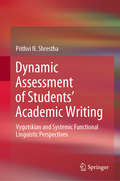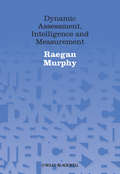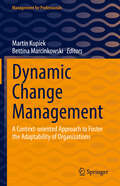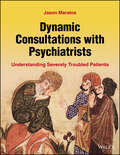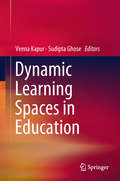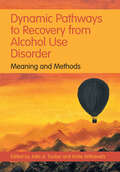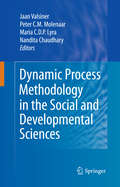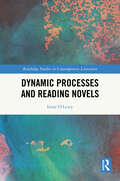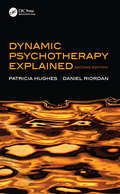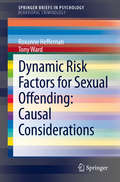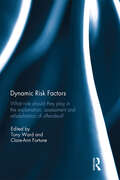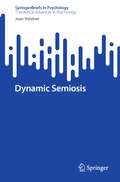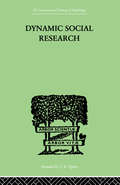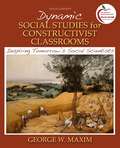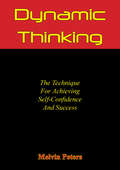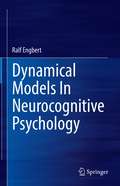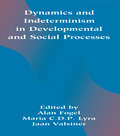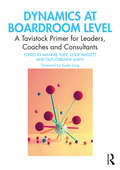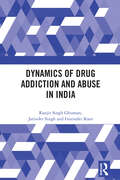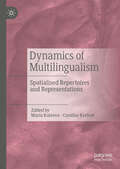- Table View
- List View
Dying: Self and Consciousness in Neuroscience, Meditation, and Philosophy
by Evan ThompsonIn the ancient Indian epic, Mahabharata, the Lord of Death asks, "What is the most wondrous thing in the world?", and his son answers, "It is that all around us people can be dying and we don't believe it can happen to us." This refusal to face the inevitability of death is especially prevalent in modern Western societies. We look to science to tell us how things are but biomedicine and neuroscience divest death of any personal significance by presenting it as just the breakdown of the body and the cessation of consciousness. The Tibetan Buddhist perspective stands in sharp contrast to this modern scientific notion of death. This tradition conceives dying not as the mere termination of living processes within the body, but as a rite of passage and transformation of consciousness. Physical death, in this tradition, initiates a transition from one of the six bardos ("in-between states") of consciousness to an opportunity for total enlightenment. In Dying: What Happens When We Die?, Evan Thompson establishes a middle ground between the depersonalized, scientific account of death and the highly ritualized notion of death found in Tibetan Buddhism. Thompson's depiction of death and dying offers an insightful neurobiological analysis while also delving into the phenomenology of death, examining the psychological and spiritual effects of dying on human consciousness. In a trenchant critique of the near-death experience literature, he shows that these experiences do not provide evidence for the continuation of consciousness after death, but also that they must be understood phenomenologically and not in purely neuroscience terms. We must learn to tolerate the "ultimate ungraspability of death" by bearing witness to dying and death instead of turning away from them. We can learn to face the experience of dying through meditative practice, and to view the final moments of life not as a frightening inevitability to be shunned or ignored, but as a deeply personal experience to be accepted and even embraced..
Dynamic Analysis in Complex Economic Environments: Essays in Honor of Christophe Deissenberg (Dynamic Modeling and Econometrics in Economics and Finance #26)
by Herbert Dawid Jasmina ArifovicThis book analyses decision-making in dynamic economic environments. By applying a wide range of methodological approaches, combining both analytical and computational methods, the contributors examine various aspects of optimal firm behaviour and relevant policy areas. Topics covered include optimal control, dynamic games, economic decision-making, and applications in finance and economics, as well as policy implications in areas such as pollution regulation. This book is dedicated to Christophe Deissenberg, a well-known and distinguished scholar of economic dynamics and computational economics. It appeals to academics in the areas of optimal control, dynamic games and computational economics as well as to decision-makers working in policy domains such as environmental policy.
Dynamic Assessment of Students’ Academic Writing: Vygotskian and Systemic Functional Linguistic Perspectives
by Prithvi N. ShresthaThis book explores the application of an innovative assessment approach known as Dynamic Assessment (DA) to academic writing assessment, as developed within the Vygotskian sociocultural theory of learning. DA blends instruction with assessment by targeting and further developing students’ Zone of Proximal Development (ZPD).The book presents the application of DA to assessing academic writing by developing a set of DA procedures for academic writing teachers. It further demonstrates the application of Hallidayan Systemic Functional Linguistics (SFL), combined with DA, to track undergraduate business management students’ academic writing and conceptual development in distance education.This work extends previous DA studies in three key ways: i) it explicitly focuses on the construction of a macrogenre (whole text) as opposed to investigations of decontextualized language fragments, ii) it offers the first in-depth application of the powerful SFL tool to analyse students’ academic writing to track their academic writing trajectory in DA research, and iii) it identifies a range of mediational strategies and consequently expands Poehner’s (2005) framework of mediation typologies. Dynamic Assessment of Students’ Academic Writing will be of great value to academic writing researchers and teachers, language assessment researchers and postgraduate students interested in academic writing, alternative assessment and formative feedback in higher education.
Dynamic Assessment, Intelligence and Measurement
by Raegan MurphyDynamic Assessment, Intelligence and Measurement paves the way for the development of dynamic assessment by applying this unique approach to the assessment of human potential. Explores the relationship that dynamic assessment shares with intelligence and measurement. Outlines a new approach to the assessment of human intelligence while remaining rooted within the scientific realm of psychology. Fuses philosophy, science methodology, and meta-theory to offer an innovative framework for the assessment of models and theories, dynamic assessment, intelligence, measurement theory, and statistical significance testing. Provides the theoretical underpinnings that can lead to a new way forward for the 'movement' of dynamic assessment.
Dynamic Change Management: A Context-oriented Approach to Foster the Adaptability of Organizations (Management for Professionals)
by Martin Kupiek Bettina MarcinkowskiThis book offers a new perspective on change projects in organizations. While traditional approaches of analysis, planning, and implementation can be too slow and unsatisfactory in dynamic environments, this book introduces a context-oriented, dynamic approach that seamlessly integrates technology, processes, and people into the organizational framework. Drawing from organizational theory, it prioritizes both the formal and informal aspects of an organization's structure and culture, and emphasizes the emotional side of change. It provides practical guidance on using emotion concepts to facilitate change in a positive way, and covers key supporting technologies, communication strategies, and human resource considerations. In addition to describing the approach, the book provides helpful tips on selecting the right consultants and embedding change know-how for future initiatives. It is an indispensable resource for anyone leading a change project or looking to improve their organization's ability to adapt. So why settle for a traditional approach when you can achieve meaningful change through a dynamic, context-oriented approach?
Dynamic Consultations with Psychiatrists: Understanding Severely Troubled Patients
by Jason MaratosDYNAMIC CONSULTATIONS WITH PSYCHIATRISTS Unique resource detailing the day-to-day activity of doctors who work on ”the coal face” of psychiatry in an acute setting Dynamic Consultations with Psychiatrists is the outcome of a collaboration between the psychiatrists of a certain hospital and the author, which has continued successfully for more than ten years, containing a number of patient consultations and cases where psychiatry was used successfully to solve a patients’ problem. The presentation of each case, and particularly of the consultation, is meant to demonstrate the process by which insights were gained. Each consultation is written in plain English with the deliberate avoidance of terminology and especially psychoanalytic jargon. Naturally, all identified features of the patients have been deleted or changed so that the patients’ privacy is not compromised. The format is near to a transcript so that the work demonstrates how the understanding evolves and emerges from the process. The structure of the book is not according to a diagnosis but according to “presenting problem” (in other words, the most prominent feature), allowing for easy and efficient accessibility. Sample concepts and learning resources covered and included in Dynamic Consultations with Psychiatrists are as follows: How a doctor is faced with a patient who is suffering in their own particular way and how the clinician gets to develop a deeper understanding of their predicament Difficulties the “coal face” doctors encounter and the challenges they will face in their personal emotional wellbeing Relationships with the other professionals both within their hospital and other agencies Curtailed histories so that there is a seamless exposition of how the conclusions of the consultation have been reached Psychiatrists, psychotherapists, and students/instructors in related programs of study can use Dynamic Consultations with Psychiatrists to gain valuable insight into the thought process of practicing psychiatrists in relation to a myriad of patient problems, allowing them to learn vicariously and become better at dealing with their own patients’ problems.
Dynamic Learning Spaces in Education
by Veena Kapur Sudipta GhoseThis volume discusses the need for a major paradigm shift in educational practice in the current digital and globalized world. It establishes a bridge between theory and praxis and revisits the objectives of learning and its modalities within the context of a rapidly evolving global world order. This volume includes perspectives from different countries on creating a dynamic and adaptive education system that encourages creativity, leadership, flexibility, and working in virtual as well as inclusive environments. The four sections include chapters that discuss creating meaningful learning environments, preparing teachers for new age classrooms, the digital learning space, fostering change in classrooms, and importantly also includes cases and experiments from schools. The authors are teacher educators, teachers and researchers, and each chapter, while being deeply rooted in theory, is juxtaposed with informed practice, making the suggestions easy to implement in different settings. This is an important resource for researchers and practitioners associated with education systems in creating engaging, meaningful and future-ready education practices.
Dynamic Pathways to Recovery from Alcohol Use Disorder: Meaning and Methods
by Katie Witkiewitz Jalie A. TuckerAlcohol use disorder is by far the most prevalent substance use disorder in the general population and is a major contributor to disease worldwide. Recovery from the disorder is a dynamic process of change, and individuals take many different routes to resolve their alcohol problems and seek to achieve a life worth living. Total abstention is not the only solution and robust recovery involves more than changing drinking practices. This volume brings together multidisciplinary research on recovery processes, contexts, and outcomes as well as new ideas about the multiple pathways involved. Experts chart the individual, social, contextual, community, economic, regulatory, policy, and structural influences that are vital to understanding alcohol use disorder and recovery. The book recommends new approaches to conceptualizing and assessing recovery alongside new avenues for research, community engagement, and policy that constitute a major shift in the practice and policy landscape.
Dynamic Process Methodology in the Social and Developmental Sciences
by Maria C.D.P. Lyra Nandita Chaudhary Jaan Valsiner Peter C. MolenaarAll psychological processes--like biological and social ones--are dynamic. Phenomena of nature, society, and the human psyche are context bound, constantly changing, and variable. This feature of reality is often not recognized in the social sciences where we operate with averaged data and with homogeneous stereotypes, and consider our consistency to be the cornerstone of rational being. Yet we are all inconsistent in our actions within a day, or from, one day to the next, and much of such inconsistency is of positive value for our survival and development. Our inconsistent behaviors and thoughts may appear chaotic, yet there is generality within this highly variable dynamic. The task of scientific methodologies--qualitative and quantitative--is to find out what that generality is. It is the aim of this handbook to bring into one framework various directions of construction of methodology of the dynamic processes that exist in the social sciences at the beginning of the 21st century. This handbook is set up to bring together pertinent methodological scholarship from all over the world, and equally from the quantitative and qualitative orientations to methodology. In addition to consolidating the pertinent knowledge base for the purposes of its further growth, this book serves the major educational role of bringing practitioners--students, researchers, and professionals interested in applications--the state of the art know-how about how to think about extracting evidence from single cases, and about the formal mathematical-statistical tools to use for these purposes.
Dynamic Processes and Reading Novels (Routledge Studies in Contemporary Literature)
by Irene O’LearyThis book is about the dynamic processes that generate novel-reading. It takes the view that the world is composed of dynamic processes and introduces a process dynamics approach to articulate this stance. This fresh perspective draws on literary studies, process philosophy and neuroscience to argue that dynamic literary and microcognitive processes constantly reconfigure the conditions that they co-create during reading. Analyses of The PowerBook by Jeanette Winterson, The Curious Incident of the Dog in the Night-time by Mark Haddon and Oryx and Crake by Margaret Atwood consider style, narration, allusion and creativity in interaction with diverse microcognitive processes involved in reading. The analyses are strengthened by taking live action into account, illuminating changes that many critical perspectives miss or standardise and avoiding reliance on illusory ideal readers and readings. In proposing a process approach to dynamics and its analysis, this book paves the way for new research across disciplines.
Dynamic Psychotherapy Explained (Radcliffe Ser.)
by Patricia Hughes Daniel RiordanThis guide aims to help doctors and nurses solve the urgent problems they encounter on the ward or in the consulting room. This edition has been updated to include the latest in advanced disease symptom control and the text emphasizes clinical decisions in relation to each symptom. It now encompasses diseases such as AIDS, motor neurone disease and other life-threatening diseases. There are new sections on psychological problems, including breaking difficult ntes. Detailed drug information now includes a formulary. The work includes a chapter on emergencies, and discusses the management of severe pain and severe agitation. The appendices provide details on syringe drivers, drug doses, adverse effects and interactions, while management advice is set out in tables, providing easy access to practical information. Each section is accompanied by a comprehensive list of bibliographic references on the relevant subject.
Dynamic Risk Factors for Sexual Offending: Causal Considerations (SpringerBriefs in Psychology)
by Tony Ward Roxanne HeffernanDynamic risk factors add a key element to the activities of practitioners seeking to reduce recidivism in criminal populations.This book focuses on the usefulness of dynamic risk factors and their ability to provide reliable information about the likelihood of reoffending. Practitioners increasingly depend on such assessments for more accurate prediction of recidivism as well as for improving the design of intervention programs.
Dynamic Risk Factors: What role should they play in the explanation, assessment and rehabilitation of offenders?
by Tony Ward Clare-Ann FortuneDynamic risk factors are the children of risk prediction. They were identified to help practitioners assess risk of recidivism and to set treatment targets likely to reduce reoffending. This resulted in the development of intervention programs designed to modify the characteristics of individuals and their environments associated with crime. The predictive nature of their legacy lies in their ability to provide reliable information about the likelihood of future reoffending. In this respect, dynamic risk factors are useful complements to static risk factors such as age, gender, and history of offending, and add incremental validity to recidivism prediction. Their treatment utility resides in the fact that practitioners increasingly rely on the identification of dynamic risk factors to direct correctional assessment and interventions. Thus, dynamic risk factors have a dual status. They are both useful predictors of reoffending and measures of risk status, and potential causes of reoffending, capable of serving an explanatory role as well as a predictive one. It is a simple and powerful conceptualization that has streamlined forensic and correctional research, program development, and the delivery of treatment. Despite its conceptual elegance we believe that the dual conceptualization of dynamic risk factors is problematic and these difficulties spill over into their role in assessment, assessment, treatment, and desistance contexts. In this publication, the nature and function of dynamic risk factors are investigated and their strengths and limitations identified. This book was originally published as a special issue of Psychology, Crime and Law.
Dynamic Semiosis (SpringerBriefs in Psychology)
by Jaan ValsinerThis book aims to bring to readers the author’s elaborated focus on the dynamic process of sign emergence, use, fixation and un-fixation, and dismissal. Its uniqueness is in its reliance on the organizing limits of irreversible time that renders the meaning construction by human beings to be constantly open-ended to face the uncertainties of the immediate future. This book emerged from a 9-month series of seminars at the Department of Semiotics at Tartu University in 2021-2022 as a Välis-Eesti Külalisprofessor, during which the linkages between semiotics and cultural psychology were scrutinized. In collaboration with doctoral students from various countries, the present SpringerBrief outlines the theoretical innovations that the author started during the seminars but completed in the two years after their end.
Dynamic Social Research
by Hader, John J & Lindeman, Eduard CFirst Published in 1999. Routledge is an imprint of Taylor & Francis, an informa company.
Dynamic Social Studies for Constructivist Classrooms: Inspiring Tomorrow's Social Scientists (9th edition)
by George W. MaximThis is the basic premise of Dynamic Social Studies for Constructivist Classrooms-- taking advantage of children’s natural curiosity and built-in desire to learn. Because this ninth edition directs primary attention to capturing the natural learning style of children, students will be referred to as “young social scientists.” The young social scientists in our classrooms put subject matter to work to find and solve problems just like practicing social scientists do. This kind of teaching does not minimize the subject matter, for social scientists rarely find a powerful and interesting problem without substantial background knowledge. It simply suggests that subject matter can be put to work to stoke the curiosity in our students.
Dynamic Thinking: The Technique For Achieving Self-confidence And Success
by Melvin PowersDynamic Thinking will teach you simple truths that are the basis of all success and will provide effective techniques for putting them to work in your life. You will learn how to harness the power of your conscious and subconscious minds and use that power to accomplish whatever you want.Melvin Powers' classic book Dynamic Thinking is your blueprint to dynamic living. It provides you with an opportunity to build the life you've wanted but never dared to believe you could have.--Wilshire Book Company
Dynamical Models In Neurocognitive Psychology
by Ralf EngbertThe development of cognitive models is a key step in the challenging research program to advance our understanding of human cognition and behavior. Dynamical models represent a general and flexible approach to cognitive modeling. This introduction focuses on applications of stochastic processes and dynamical systems to model cognition. The dynamical approach is particularly useful to emphasize the strong link between experimental research (and its paradigms), data analysis, and mathematical models including their computer implementation for numerical simulation. Most of specific examples are from the domain of eye movement research, with concepts being applicable to a broad range of problems in cognitive modeling. The textbook aims at the graduate and/or advanced undergraduate level for students in Cognitive Science and related disciplines such as Psychology and Computer Science. Joint introduction of the theory of cognitive processes and mathematical models, their underlying mathematical concepts, numerical simulation, and analysis;The focus on eye movements provide a theoretically coherent, but very general application area;Computer code in R Programming Language for Statistical Computing is available for all examples, figures, and solutions to exercises.
Dynamically Oriented Art Therapy: Its Principles and Practice, Illustrated with Three Case Studies
by Margaret NaumburgThis book uses 3 emotionally disturbed women to illustrate how the art of therapy works in treatment.
Dynamics and indeterminism in Developmental and Social Processes
by Jaan Valsiner Alan Fogel Maria C. D. P. LyraOne of the most profound insights of the dynamic systems perspective is that new structures resulting from the developmental process do not need to be planned in advance, nor is it necessary to have these structures represented in genetic or neurological templates prior to their emergence. Rather, new structures can emerge as components of the individual and the environment self-organize; that is, as they mutually constrain each other's actions, new patterns and structures may arise. This theoretical possibility brings into developmental theory the important concept of indeterminism--the possibility that developmental outcomes may not be predictable in any simple linear causal way from their antecedents. This is the first book to take a critical and serious look at the role of indeterminism in psychological and behavioral development. * What is the source of this indeterminism? * What is its role in developmental change? * Is it merely the result of incomplete observational data or error in measurement? It reviews the concepts of indeterminism and determinism in their historical, philosophical, and theoretical perspectives--particularly in relation to dynamic systems thinking--and applies these general ideas to systems of nonverbal communication. Stressing the indeterminacy inherent to symbols and meaning making in social systems, several chapters address the issue of indeterminism from metaphorical, modeling, and narrative perspectives. Others discuss those indeterministic processes within the individual related to emotional, social, and cognitive development.
Dynamics at Boardroom Level: A Tavistock Primer for Leaders, Coaches and Consultants
by Leslie Brissett Mannie Sher Tazi Lorraine SmithHow can boards and members of boards reach their full potential? The Tavistock Institute of Human Relations (TIHR) has been at the forefront of thinking about organizations since its inception in 1947. Today, as then, the corporate world is undergoing increasing pressure to demonstrate a sustainable, generative and meaningful impact on society and employees whilst delivering improved services and products. These tensions and others are explored in this important new book, Dynamics at Boardroom Level: A Tavistock Primer for Leaders, Coaches and Consultants. In this book, the reader gets a useful framework of theory and practice that broadens vision and deepens thinking about what is happening in boardrooms. The book opens the door to the reader to a new world of board dynamics, edited by those who really understand the deeper workings of the complex human system and its work at board level. This edited volume brings together the insights and contemporary case studies from participants on the Tavistock Institute Dynamics @ Board Level programme that draws on the thinking of Tavistock scholars and practitioners and their work on the dynamics of task, role, authority and power. Edited by programme co-directors Dr Mannie Sher and Dr Leslie Brissett and their fellow Tavistock Associate Tazi Lorraine Smith, and with contributions from senior leadership practitioners and board evaluators from the government, international consultancy firms, FTSE 100 and global UN institutions, this book speaks directly to issues of our time. It represents essential reading for leaders of organizations and businesses, as well as leadership coaches and mental health professionals.
Dynamics at Boardroom Level: A Tavistock Primer for Leaders, Coaches and Consultants
by Susan Long Leslie Brissett Mannie Sher Tazi Lorraine SmithHow can boards and members of boards reach their full potential? The Tavistock Institute of Human Relations (TIHR) has been at the forefront of thinking about organizations since its inception in 1947. Today, as then, the corporate world is undergoing increasing pressure to demonstrate a sustainable, generative and meaningful impact on society and employees whilst delivering improved services and products. These tensions and others are explored in this important new book, Dynamics at Boardroom Level: A Tavistock Primer for Leaders, Coaches and Consultants. In this book, the reader gets a useful framework of theory and practice that broadens vision and deepens thinking about what is happening in boardrooms. The book opens the door to the reader to a new world of board dynamics, edited by those who really understand the deeper workings of the complex human system and its work at board level. This edited volume brings together the insights and contemporary case studies from participants on the Tavistock Institute Dynamics @ Board Level programme that draws on the thinking of Tavistock scholars and practitioners and their work on the dynamics of task, role, authority and power. Edited by programme co-directors Dr Mannie Sher and Dr Leslie Brissett and their fellow Tavistock Associate Tazi Lorraine Smith, and with contributions from senior leadership practitioners and board evaluators from the government, international consultancy firms, FTSE 100 and global UN institutions, this book speaks directly to issues of our time. It represents essential reading for leaders of organizations and businesses, as well as leadership coaches and mental health professionals.
Dynamics of Drug Addiction and Abuse in India
by Jatinder Singh Ranjit Singh Ghuman Gurinder KaurThis book analyzes drug addiction and abuse from the perspectives of the state and community in India, with a special focus on North-West regions of India. India lies in the transit route of two major global centres of heroin and cocaine processing: the Golden Triangle of Myanmar, Thailand and Laos towards the East; and the Golden Crescent of Afghanistan, Iran and Pakistan to the West making it vulnerable to drug trafficking and curbing this has been a tough challenge for enforcement agencies. The book looks at: the nature and pattern of drug addiction across the age groups, gender and occupational groups, both in rural and urban areas in India; the socio-economic causes of drug-use and addiction and the various socio-economic costs associated with it; the general perception of family members, police and political leaders on drug addiction as well as rehabilitation; and available mechanisms to address the issue at the level of family, society and government and the changes required in policy to curb drug addiction and use This interdisciplinary book will be of importance to students and researchers of economics, cultural and social anthropology, sociology, police administration, political science, and psychology. It will also be of interest to policy makers, government agencies, social scientists, departments of social and preventive medicine, social workers, civil society, drug-addicts and their families.
Dynamics of Family and Intimate Partner Violence
by Christina E. Newhill Irene Hanson Frieze Rachel FuscoThis book provides a research-based analysis of the dynamics of several types of violence in families and close relationships, as well as a discussion of theories relating to the experiences of victims. Drawing on recent research data and case studies from their own clinical experiences, the authors examine causes, experiences, and interventions related to violence in various forms of relationships including children, elders, and dating or married couples.Among the topics covered:Causal factors in aggression and violenceTheories of survivor coping and reactions to victimizationInterventions for abused women and childrenOther forms of family violence: elder abuse, sibling abuse, and animal crueltySocietal responses to abuse in the familyDynamics of Family and Intimate Partner Violence is a crucial resource for practitioners and students in the fields of psychology and social work, vividly tying together theory and real-life case studies.
Dynamics of Multilingualism: Spatialised Repertoires and Representations
by Caroline Kerfoot Maria KuteevaThis edited book focuses on the ways in which contemporary societal challenges are constructed, mediated and lived through language and other semiotic modalities in new on- and off-line spaces. It conceives of linguistic repertoires as part of dynamic assemblages that can enable an understanding of the ways in which different bodies, lived experiences, discourses, semiotic resources, and objects intra-act, change and ‘become’ together in unpredictable ways. The chapters reveal the conditions under which such assemblages occur and the nature of the entangled elements that enable certain practices to emerge and then either to endure or disappear, drawing on a range of critical sociolinguistic and discourse analytical methods to explore how histories, languages, bodies, and the material realisation of each space intra-act in the production of determinations of (linguistic) legitimacy and worth, shaping contemporary ideologies of belonging and, thereby, other possibilities. This book will be of interest to students and researchers in fields including sociolinguistics, anthropology, migration studies, and education.


